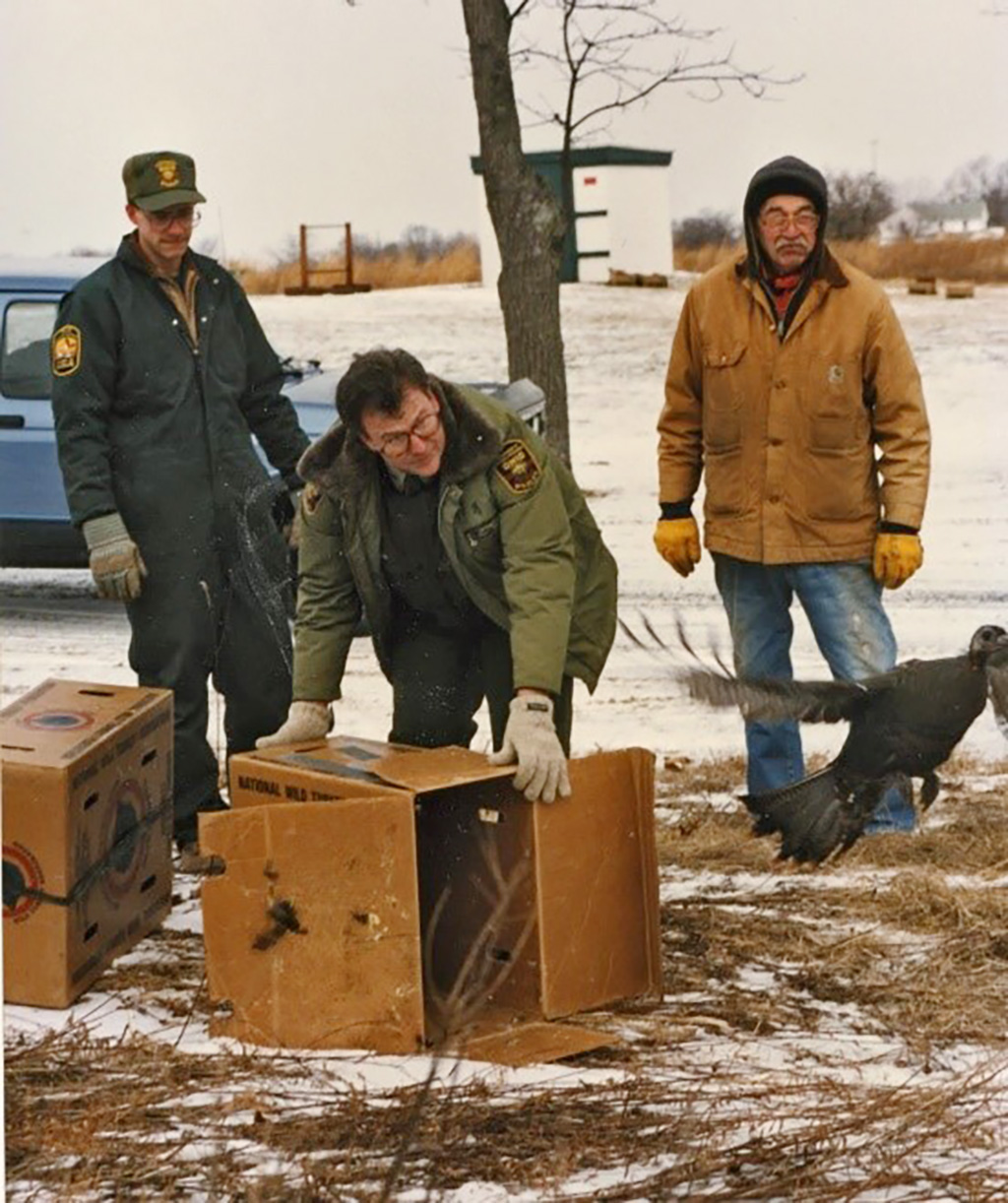I got up early the other morning, stepping outside to a fresh dusting of a spring snow. Drug into the yard by Briar’s aging bladder, I waited while she chose just the right spot to relieve herself — a task only a spaniel can take 10 minutes to accomplish. I was still in my pajamas and moccasin slippers, having forsaken any jacket.
Finished with her business, Briar decided an inspection of the yard was in order. I think she just likes to see me shiver. I barked a short command for her to hurry her furry self up when it happened.
As my voice echoed off our barn, I was answered by a yodel emanating from our river bottom. The dog, deaf to most human commands, froze in mid-step, perked her ears, turning her nose into the wind. I followed suit, though my nose was of little use. I strained my eyes and ears, waiting…
A doe, creeping along the edge of our conservation plantings, expressed a cocked-ear interest. It came again; this time much clearer. It wasn’t any closer, just sharper due to my concentration. Briar and the deer didn’t budge and neither did I.
This time, that rich, commanding gobble was answered by a second from far behind the first. The deer gave a steamy snort into the brisk air, a single foot stomp and vanished into a windbreak. Briar, satisfied that the sound was familiar, headed for the porch. But I wasn’t ready to go inside. I stood and listened, but apparently the concert was over. Walking back to the porch, I let the now impatient dog back into the house.
During my youth, seeing a deer — any deer — held a mesmerizing fascination. They were so rare that I was awestruck whenever I’d see one. Over time, deer numbers have increased substantially and now spotting one no longer draws the wonder it once offered — not so with wild turkeys. Each year, spring’s first gobble makes the sunrise just that much sharper.
Comeback

Turkeys and white-tails once suffered the same fate. By about 1910, habitat destruction and unchecked hunting had extirpated both from Ohio. Deer were the first to bounce back during the Roaring ‘20s, and turkey reintroduction began in the 1950s. Still, most of Ohio remained turkey-less. Habitat studies during the 1980s encouraged Division of Wildlife biologists to expand restocking into areas that hadn’t seen a wild turkey for over 100 years. Today, Old Tom’s wake-up call can be heard in every county.
Maybe they fascinate me because they’re relatively new and a bit of a novelty, but I don’t think that’s it. There’s just something about that excited gobble swelling out of a river bottom or echoing off a ridge that makes me smile like a kid on Christmas morning. Its magnetic pull draws you toward the woods for just a glimpse of their full-strut waltz, to share an excitement that they must feel about the prospects of a new day.
I’m not alone concerning this hypnotic pull of the turkey’s call. Hunters have a long history of duplicating the puts and purrs of hens and the gobbler’s yodeling, hoping to bring them close enough to feed their family. Of course, duck hunters have been doing the same thing, coaxing wide-swinging flights of ducks and geese toward decoys. There just seems to be something a little extra-special about turkey calling. I’m not exactly sure why, though I have my ideas.
Something special
Duck calls have been a specialty market as long as there have been hunters and ducks. Many fine examples have been crafted with avid collectors always on the lookout for original Phillip Olt, Chick Major, Ken Martin and others that date back to the marshes of the 1930s. Even recent builders are putting out calls that can startle an accountant.
For instance, a 10-year-old Paul Kingyon handmade call carried an asking pinch of $2,000. Was it plated in platinum? Nope, it was just a hand-carved, single-reed call that’s really good at fooling ducks. A lot of waterfowl hunters I’ve known carry such a variety of wood-carved calls on neck lanyards that if they ever fell out of their boat, they wouldn’t need a life jacket.
Turkey calls also have their collectible market, but theirs has a bit different clientele. See, duck hunting is usually done as a group and, if they’re lucky, a good retriever. The shooting can be hot and fast between long periods of sitting in a blind and discussing the things important to waterfowl hunters — good dogs, best loads, hot coffee, favorite whiskey, old friends and perfect calls. Everyone has an opinion and there’s time to share them as they wait for the next flight. This all helps to drive the widespread interest in collecting waterfowl calls as well as decoys.
Turkey hunters tend to be solitary. They’ll sometimes hunt as a two-person team, but most often the hunter is in the woods on a solo trip to bag a bird. It’s a quiet time to think, plan and strategize. It’s a time to silently watch the wild-world wake up while reflecting on time. There’s nobody to discuss the best of anything — that’s left to the silent thoughts of the hunter. Somehow, turkey hunting seems more personal.
Rare find
There are turkey call collectors, but not yet in the numbers of folks looking for antique waterfowl gear. Still, some turkey calls can be pricey and even rarer to find. One such call, made in 1898 by Louisianian Charles L. Jordan, is 8 inches long and made from a wing bone of a wild turkey.
Jordan didn’t manufacture calls as much as he made them for his friends and their friends. Jordan was considered the reigning turkey hunting expert, having also penned most of the 1914 book “The Wild Turkey and Its Hunting” — a book that was completed by Edward A. McIlhenny — the first written on the subject and a collectible item itself. Replicas of Jordan’s “yelper” call have been made for years, so finding an original is tough and the risk of being duped real.
Then, one seemingly surfaced on eBay. A Texan had purchased the call at an antique firearms sale and placed it on the auction site. When listed, he started fielding questions about his find — a lot of questions. Believing he might be making a mistake, he pulled the call off of the site.
Lucky for him, North Carolinian Danny Ellis heard about the Jordan call and was able to track the Texan down. An avid turkey call collector, Ellis explained to the gentleman what he might have. An inspection was arranged and Ellis had indeed found the Holy Grail of turkey calls. It wasn’t cheap, but Ellis purchased the call from the now well-educated antique arms enthusiast. After verifying its provenance, including Jordan’s original presentation inscription, the yelper fetched $50,000. Both men were ecstatic about the deal, with Ellis believing that the Jordan call would one day bring a six-figure price.
Built by hunters
The value wasn’t because Jordan made the first bone-yelper call. In fact, it’s likely that Native Americans have been turning out turkey calls for eight-thousand years. It was Jordan’s notoriety and the call’s rarity that collected the premium. What continues to make turkey calls so interesting is their evolution and the variety of handmade and commercial examples available. There are box and friction calls, wing bone yelpers, push-pin, tube calls and the diaphragm call that fits inside the mouth. If you have a gag-reflex, that last one is definitely not for you.
To me, the most important and collectible calls are those built by hunters. They turn them into folk art, the most popular being the box, wing bone and slate calls. Some are plain while others have intricate carvings and wood burnings. Most are made in small quantities and carry a quilter’s charm and love in their creation. They’re tuned to the builder’s ear and carry the history of past hunts in their creation. They’ll also help you collect Tom Turkey if you do your part.
One more thing — I mentioned that Charles Jordan wrote most of the book “The Wild Turkey and Its Hunting,” but that it was completed by Edward McIlhenny. It wasn’t that Jordan wouldn’t have liked to finish his book, but his life was cut short when he was murdered in the turkey woods in 1909. At the time, Jordan was the manager of the Morris Game Preserve in Hammond, Louisiana.
Ohio’s wild turkey hunting seasons are: Youth Season, April 12-13; South Zone, April 19-May 18; Northeast Zone, May 3-June 1. Always double checks season dates and regulations before your hunt.
“A duck call in the hands of the unskilled is one of conservation’s greatest assets.”
— Nash Buckingham













